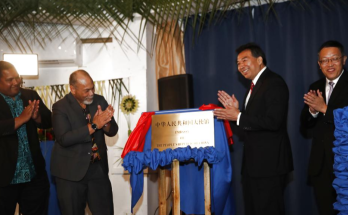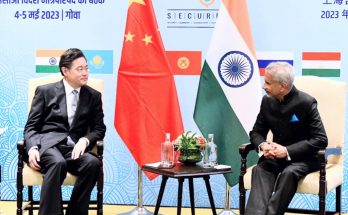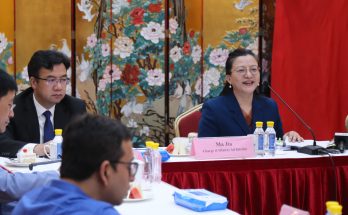 On the day Chinese President Xi Jinping arrived in Gujarat on September 17, The Hindu newspaper published an op-ed called ‘Towards an Asian century of prosperity’ in which President Xi spoke of his country as the factory and India as the world’s back office, he referred to the new government in power bringing in new reforms. He spoke of deepened mutual trust by “strengthening strategic dialogue and enhancing political confidence.” The article was expectedly replete with bonhomie and optimism although India was not too happy being relegated to the back office. Nevertheless, Xi concluded by saying that he was “confident that as long as China and India work together, the Asian century of prosperity and renewal will surely arrive at an early date.” All this sounded wonderful.
On the day Chinese President Xi Jinping arrived in Gujarat on September 17, The Hindu newspaper published an op-ed called ‘Towards an Asian century of prosperity’ in which President Xi spoke of his country as the factory and India as the world’s back office, he referred to the new government in power bringing in new reforms. He spoke of deepened mutual trust by “strengthening strategic dialogue and enhancing political confidence.” The article was expectedly replete with bonhomie and optimism although India was not too happy being relegated to the back office. Nevertheless, Xi concluded by saying that he was “confident that as long as China and India work together, the Asian century of prosperity and renewal will surely arrive at an early date.” All this sounded wonderful.
Yet, unknown to many who read this op-ed, there was unprecedented PLA activity in Chumur, Ladakh even as Prime Minister Modi was getting ready to receive his guest in Ahmedabad. A force of about 1,000 PLA troops had intruded four to five kilometres inside and the response from the Northern Command was swift when it deployed 1,500 troops immediately. A smaller intrusion would have been treated as routine, boring and déjà vu as the Chinese do it each time there is a high level India-China exchange of visits.
Besides, the new government in New Delhi had to be tested as early as possible, especially after PM Modi’s just concluded successful visit to Japan and ahead of his visit to the US. This time, however, the Chinese persisted with their pointless obduracy during a state visit of the President. There have been several speculations about why the Chinese acted this way but the point is that this will not be without some cost to the Chinese. The Chinese continued to show premature hubris and this will have prompted Indian strategist planners to rethink approaches to China and to the US.
The Chinese would have realised that things were somewhat different this time. Tibetan protesters mysteriously showed up at the venue of the conference despite the three layers of security. However, there were slip ups as pointed by strategic analyst Brahma Chellaney and former foreign secretary Kanwal Sibal in their commentaries. We had allowed a reference to the ‘local government of Tibet Autonomous Region of the Peoples’ Republic of China’ in acknowledging the help to Indian pilgrims visiting Kailash-Mansarovar via Nathu-la in the joint statement. For the Chinese, this sleight of hand was again tantamount to India reconfirming that Tibet was a part of China. We could not get the Chinese to commit to a One India policy.
There was considerable misinformed hope that China would invest US $100 billion in India. This figure came from some academic speculation in Shanghai and it was picked up here. There was never any official offer of this amount. In the end, a US $20 billion commitment was considered a letdown. In reality, it was a jump from the present US $400 million investment and we were victims of our self-created hype.
India’s relations with China and Pakistan are unlikely to see any major strategic change in the years ahead and we are really going to remain a landlocked country. Trade and access to resources and markets will be through the Indian Ocean. China also seeks facilities all along the IOR littoral and one day Chinese naval ships will appear in the IOR.
The Chinese had decided to play for high stakes in Ladakh during Xi’s visit despite brewing problems in Hong Kong, existing insurgency issues in Xinjiang, continuing confrontation in the Western Pacific. Possibly this move was conditioned by Beijing’s assessment that the US pivot to Asia had been weakened by the crises in the Ukraine and West Asia. The Chinese attitude towards India remains that they had the resources and funds to help other economies in the region but India was unable to compete economically or militarily with China.
It is imperative for India to think afresh without losing old friends especially at a time of international flux. A US-Japan-India partnership in the 21st century would need to be worked out. It might be uphill, the US is not at all an easy country to handle when it comes to preserving and enhancing its own national interests. Mutual interests will continue to be sharply defined by Americans in narrow American terms with a demanding corporate sector and there will be serious swings but it can be done.
(The writer is an Adviser to Observer Research Foundation, Delhi)
Courtesy: ORF
Author Profile
- India Writes Network (www.indiawrites.org) is an emerging think tank and a media-publishing company focused on international affairs & the India Story. Centre for Global India Insights is the research arm of India Writes Network. To subscribe to India and the World, write to editor@indiawrites.org. A venture of TGII Media Private Limited, a leading media, publishing and consultancy company, IWN has carved a niche for balanced and exhaustive reporting and analysis of international affairs. Eminent personalities, politicians, diplomats, authors, strategy gurus and news-makers have contributed to India Writes Network, as also “India and the World,” a magazine focused on global affairs.
Latest entries
 DiplomacyApril 10, 2024Diplomat-author Lakshmi Puri pitches for women power at LSR
DiplomacyApril 10, 2024Diplomat-author Lakshmi Puri pitches for women power at LSR India and the WorldApril 6, 2024UN envoy pitches to take India’s solutions to the world stage
India and the WorldApril 6, 2024UN envoy pitches to take India’s solutions to the world stage CultureApril 5, 2024Youth in Diplomacy: Making it Matter with LSR Model UN 2024
CultureApril 5, 2024Youth in Diplomacy: Making it Matter with LSR Model UN 2024 India and the WorldMarch 28, 2024India to China: Normalization of troops deployment imperative for restoring ties
India and the WorldMarch 28, 2024India to China: Normalization of troops deployment imperative for restoring ties







